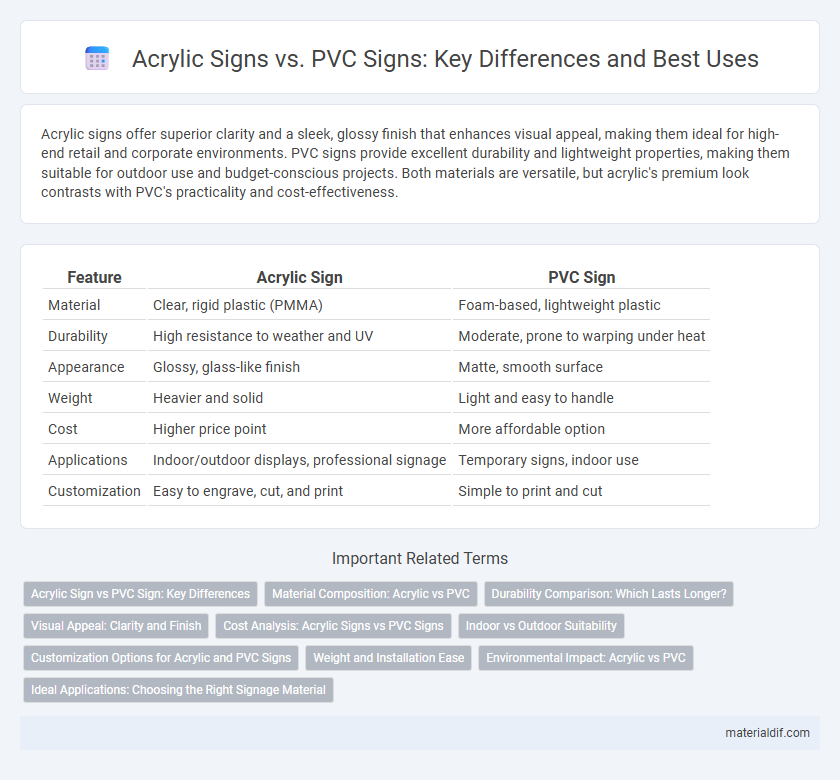Acrylic signs offer superior clarity and a sleek, glossy finish that enhances visual appeal, making them ideal for high-end retail and corporate environments. PVC signs provide excellent durability and lightweight properties, making them suitable for outdoor use and budget-conscious projects. Both materials are versatile, but acrylic's premium look contrasts with PVC's practicality and cost-effectiveness.
Table of Comparison
| Feature | Acrylic Sign | PVC Sign |
|---|---|---|
| Material | Clear, rigid plastic (PMMA) | Foam-based, lightweight plastic |
| Durability | High resistance to weather and UV | Moderate, prone to warping under heat |
| Appearance | Glossy, glass-like finish | Matte, smooth surface |
| Weight | Heavier and solid | Light and easy to handle |
| Cost | Higher price point | More affordable option |
| Applications | Indoor/outdoor displays, professional signage | Temporary signs, indoor use |
| Customization | Easy to engrave, cut, and print | Simple to print and cut |
Acrylic Sign vs PVC Sign: Key Differences
Acrylic signs offer superior clarity, durability, and weather resistance compared to PVC signs, making them ideal for high-impact visual displays and outdoor use. PVC signs are lightweight, cost-effective, and flexible but lack the rigid structural strength and premium finish that acrylic provides. Choosing between acrylic and PVC depends on the desired balance of durability, aesthetic appeal, and budget for custom signage projects.
Material Composition: Acrylic vs PVC
Acrylic signs are made from polymethyl methacrylate (PMMA), a rigid, transparent thermoplastic known for its glass-like clarity and UV resistance, making it ideal for vibrant, durable displays. PVC signs are composed of polyvinyl chloride, a flexible plastic that offers excellent impact resistance and weatherproofing but tends to lack the optical clarity of acrylic. The distinct material properties influence the choice between acrylic's high-gloss finish and PVC's robustness for signage applications.
Durability Comparison: Which Lasts Longer?
Acrylic signs exhibit superior durability compared to PVC signs due to their resistance to UV rays, weathering, and impact, making them ideal for long-term outdoor use. PVC signs are more prone to cracking and fading over time when exposed to harsh environmental elements, reducing their lifespan significantly. For businesses seeking longevity and sustained visual appeal, acrylic signs offer a more durable and weather-resistant solution.
Visual Appeal: Clarity and Finish
Acrylic signs offer superior visual appeal due to their high-gloss, crystal-clear finish that enhances color vibrancy and sharpness. PVC signs tend to have a matte or less reflective surface, resulting in subdued colors and a flatter appearance. The clarity and smooth finish of acrylic make it ideal for premium signage requiring striking visual impact.
Cost Analysis: Acrylic Signs vs PVC Signs
Acrylic signs typically cost more than PVC signs due to higher material and fabrication expenses, averaging $25 to $40 per square foot compared to PVC's $15 to $30 range. Acrylic offers a premium glossy finish and greater durability, justifying the price difference for businesses seeking a polished appearance. PVC signs are more budget-friendly and lightweight, making them ideal for short-term or indoor use where cost-efficiency is a priority.
Indoor vs Outdoor Suitability
Acrylic signs offer superior UV resistance and weather durability, making them ideal for outdoor use where exposure to sunlight and moisture occurs. PVC signs, composed of lightweight plastic material, perform well indoors due to their affordability and ease of customization but may degrade under prolonged outdoor conditions. Selecting acrylic ensures longer-lasting signage outdoors, while PVC is more cost-effective and sufficient for indoor display needs.
Customization Options for Acrylic and PVC Signs
Acrylic signs offer extensive customization options including vibrant color choices, varying thicknesses, and the ability to incorporate intricate laser-cut shapes and embedded LED lights for enhanced visual appeal. PVC signs provide flexibility in size and thickness and are ideal for printing detailed graphics with weather-resistant coatings, making them suitable for outdoor use. Both materials support full-color digital printing, but acrylic excels in delivering a glossy, high-end finish with greater design versatility.
Weight and Installation Ease
Acrylic signs are generally lighter than PVC signs, making them easier to handle and install, especially for wall mounting or hanging applications. The smooth, glossy surface of acrylic provides a polished appearance but requires careful drilling to avoid cracking, whereas PVC signs, while slightly heavier, offer greater durability and can be easily cut and drilled with standard tools. Choosing between acrylic and PVC depends on the specific weight tolerance and installation environment of the signage project.
Environmental Impact: Acrylic vs PVC
Acrylic signs are more environmentally friendly than PVC signs due to their recyclability and lower toxic emissions during production. PVC signs release harmful chemicals such as dioxins and chlorine into the environment, posing significant health and ecological risks. Choosing acrylic reduces carbon footprint and supports sustainable signage solutions.
Ideal Applications: Choosing the Right Signage Material
Acrylic signs excel in indoor applications where clarity, gloss, and durability under moderate conditions are essential, such as retail displays, office signage, and exhibition panels. PVC signs are better suited for outdoor and budget-friendly projects, offering resistance to moisture and impact while maintaining cost-effectiveness for construction sites, directional signs, and temporary advertising. Selecting between acrylic and PVC depends on the specific environmental exposure, desired finish, and longevity requirements of the signage project.
Acrylic Sign vs PVC Sign Infographic

 materialdif.com
materialdif.com